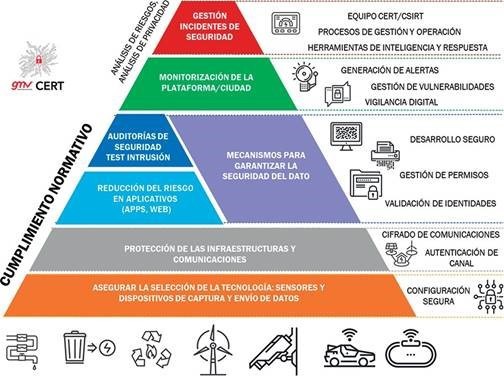SMART, transparent cities

The concepts of Smart City and Internet of Things go hand in hand. A Smart City knows how to tap into the benefits of technology to improve the city management process. IoT enhances knowledge of the city’s various services while also favoring their ongoing management and instant access to all information in real time. All this is conducive to better, data-driven decision-making. Smart sensors play a crucial role in the ongoing improvement of a city’s services, such as street lighting, irrigation systems, garbage collection, safety/security, mobility, etc.
And a constant check on all this new infrastructure is kept by means of data-displaying, -mining, -management and -monitoring platforms. Sensor rollout and real-time information are both crucial features for any efficient city management but they have to be allied with constant infrastructure monitoring at both health and safety/security level.
Design-up security, after all, is a vital part of smart-city management. Sensor placement has to abide by the security strategy laid down by Spain’s National Security Scheme. A constant check has to be kept on any potential threat and entry vector that might undermine information-confidentiality, -authenticity or -availability, while also heading off any unauthorized tampering with the sensor or its information. All this infrastructure must also be equipped with proper infrastructure-security management.
As could hardly be otherwise, Spain’s cities are working hard to improve their management procedures and provide their citizens with digital services, in short to become “smarter”. One of the initiatives currently being worked on to enhance the efficiency of infrastructure and urban services, to cut public spending and improve the quality of citizen services is the Spanish Smart City Network (Red Española de Ciudades Inteligentes: RECI). It now comprises over eighty cities that are taking up new service-improving technology, bringing in new sensors and control and metering devices.
The various Digital Agendas are one of the main levers for improving citizens’ quality of life: the two Smart City calls (where GMV is leading one of its projects, Smart Cities: Open Government, Collaborative and Interoperable Platform) the Smart Islands initiative or the National Smart Territory Plan (knitted into smart-resort, smart-building and pilot 5G projects) give continuity to a national smart city strategy in Spain.
The Key Feature: Data
As of today we are rolling out a wide range of sensors and devices, but another crucial piece of the puzzle is the necessary data-mining tools to be able to extract from the data the evidence to favor and enhance city-management decision-making. Data analysis is crucial here, helping to pinpoint the cities’ problems and weak points, including the crosschecking of data between different services to identify citizen behavior and trends. Knowing how to apply intelligence to this data will enable us to improve cities’ digital services.
Two types of skilled personnel are crucial here: the functional public-service professionals (a keystone in understanding any city) and qualified teams to run this type of data mining and analysis technology.
The right steps are now being taken; the projects are underway; but we should not slacken in our ongoing efforts to make the most of this ocean of such high-potential data.
We also need city managers who understand citizen needs and are cognizant of available resources to work with. Above all they must be technology savvy. A proper use of the technology is a resource multiplier factor, with the knock-on effect of improving citizen services. Innovation and technology have to be part and parcel of any great city’s evolution. Above all it must be accompanied by account rendering portals. City government must always be open and transparent to make sure all citizens are always well aware of the impact of public investments and outlays.
Author: Patricia Tejado